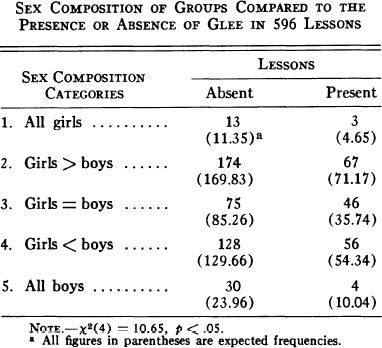November 30, 2006
Group glee
One of the best things about teaching undergraduates is how much you learn. Yesterday, a student and I were discussing possible sources for his term paper on "intrinsically funny words", and as we poked around on Google Scholar, we stumbled over Lawrence W. Sherman, "An Ecological Study of Glee in Small Groups of Preschool Children", Child Development, 46(1) 53-61 1975. The abstract:
A phenomenon called group glee was studied in videotapes of 596 formal lessons in a preschool. This was characterized by joyful screaming, laughing, and intense physical acts which occurred in simultaneous bursts or which spread in a contagious fashion from one child to another. A variety of precipitating factors were identified, the most prevalent being teacher requests for volunteers, unstructured lags in lessons, gross physical-motor actions, and cognitive incongruities. Distinctions between group glee and laughter were pointed out. While most events of glee did not disrupt the ongoing lesson, those which did tended to produce a protective reaction on the part of teachers. Group glee tended to occur most often in large groups (7-9 children) and in groups containing both sexes. The latter finding was related to Darwin's theory of differentiating vocal signals in animals and man.
The exact definition of "group glee", from the body of the paper:
A general description of group glee was first established as a very intense, joyfully affective state maintained throughout a majority of the group (one-half or more). To isolate a critical incident of group glee, two crieteria, noted in the codes as behavioral manifestation and ratio, had to be present.
Behavioral manifestation. -- Three categories of overt behaviors through which group glee manifested itself were laughter (Laf), screaming (Scr), and intense physical acts (Phys). Laughter was limited to instances of vigorous and joyful laughter. Screaming as limited to ebullient vocalizations which were emitted either in an organized, chantlike fashion or in random disarray. Intense physical actions were described as joyful physical behaviors such as hand clapping, jumpting up and down, or other intense physical expressions. [...]
Ratio. -- If one of the behavioral manifestations or combinations thereof was recognized, a ratio of the number of children involved in the the incident to the number of children present at its occurrence was calculated. If this ratio was 50% or more, an incident of group glee was noted as being present.
Sherman found ten categories of "precipitating causes". All of them are familiar -- group physical activity (like dancing lessons), cognitive incongruity (painting with a string, or making a speech error), taboo-breaking (transgressing the teacher's authority or using a taboo word like "stinky-pu"), suspense-resolution and terminal points of activities, etc. The student's concept of "instrinsically funny word" came up in a couple of different categories: nonsense words and nonsensical phrases are examples of "cognitive incongruity", whereas words like "underwear" would be in the taboo-breaking category. (The commonest single category among Sherman's precipitating factors was the "me, me, me" response to requests for volunteers, which seems to like a somewhat different kind of behavior from the other sorts of group glee discussed.)
What caught my attention was the table reproduced below:

This shows a slight but significant tendency for group glee to occur more often in mixed-sex groups. You may be able to see the pattern a bit more clearly if we redo the table in terms of the percent of lessons in which group glee occurred:
Group composition |
Group glee (percent of lessons) |
| All girls | 19% |
| Girls > boys | 28% |
| Girls = boys | 38% |
| Girls < boys | 30% |
| All boys | 12% |
Sherman's paper was published in 1975, and there seems to have been relatively little work on the subject since then. If I was the Emperor of Academia, we'd have Departments of Group Glee Studies, Institutes for Interdisciplinary Group Glee Research, international workshops on Cross-cultural Group Glee Investigations, annual meetings of the American Group Glee Association (and its splinter group, the Association for Group Glee Science)... Well, maybe not. But at least there'd be some more research. Just think of the applications in stand-up comedy, for example.
Posted by Mark Liberman at November 30, 2006 05:32 AM